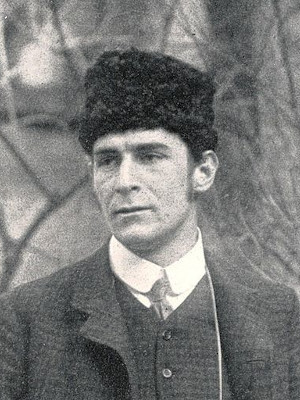Franz Marc

Franz Marc was a German painter, draftsman and graphic artist and is still regarded today as one of the most important painters of Expressionism in Germany. He co-founded the editorial community "Der Blaue Reiter" (eng.: The Blue Rider) and wrote art theoretical writings for it.
Franz Moritz Wilhelm Marc was born on 08 February 1880 as the second and last son of the Marc family in Munich. He and his older brother later attended the Luitpold Gymnasium in Munich, where they were for a time classmates of Albert Einstein. While his older brother decided to study theology, Franz enrolled for postgraduate studies at the Ludwig Maximilians University in Munich for a philology degree. However, even before he began his studies, he had to start his one-year military service, where he learned to ride. During this time he decided to take up the profession of his father, who was a landscape and genre painter.
In May 1901 he enrolled at the Munich Academy of Fine Arts and was taught anatomy and painting in the tradition of the 19th century Munich School of Painting.
With a study friend he made in May 1903 a journey through France. He toured Brittany and Normandy and visited museums in Paris, looked at ancient paintings and made copies of some of the paintings in the Louvre. He studied the sights, drew in the streets and bought in the art trade Japanese woodcuts, whose technique and composition impressed him very much. Soon afterwards, he returned to Munich to his school, to leave them again in September of the same year, disappointed by the academic teaching.
In 1906 he undertook a study trips to his brother in Greece, who had become a Byzantine, and visited Salonika and Mount Athos. A year later, he returned to Paris, where he was impressed by the works of Vincent van Gogh and Paul Gauguin and wrote enthusiastic reports on the Paris art and exhibition scene.
In February 1910, Franz Marc had his first solo exhibition at the Kunsthandel Brakl, which included a total of 31 works.
After he briefly was a member of the "Neue Künstlervereinigung München" (engl.: New Artists´ Association Munich), he resigned there after disputes soon again to found with other fellow artists, the editorial community of the " Der Blaue Reiter". On 18 December 1911 the first exhibition of the editorial department "Der Blaue Reiter" was opened in the Galerie Thannhauser. Fourteen artists were represented at this first exhibition:
Besides Franz Marc, Wassily Kandinsky, the brothers Burljuk, Heinrich Campendonk, Robert Delaunay, Jean-Bloé Niestlé, Elisabeth Epstein, August Macke, Gabriele Münter, Henri Rousseau and Arnold Schönberg.
Franz Marc used techniques such as oil paints, gouaches, pencil and watercolor as well as woodcuts for his works. As a symbol of originality and purity, he preferred animals as a motive, since in his eyes they embody the idea of creation and live in harmony with nature.
Franz Marc was drafted at the height of his work for military service in the First World War. He fell on March 4, 1916 on the French front when he was on a reconnaissance ride. He was hit by a shrapnel near Verdun. He was only 36 years old.
His obituary in "The Storm" was:
"Now an artist has fallen that cannot fall. His kingdom is not of this world. But the earth was at home to him. The earth that creates life and carries life. The earth seemed to him, the animals, the woods and the rocks were talking to him. "
by Herwarth Walden for "Der Sturm" ( engl.: “The Storm” a former German Journal of Expressionism )
Text: Nadja von der Hocht
Foto: Urheber Unbekannt [Public domain]

